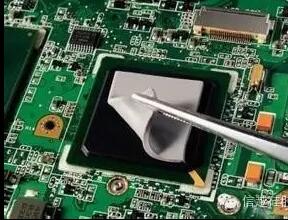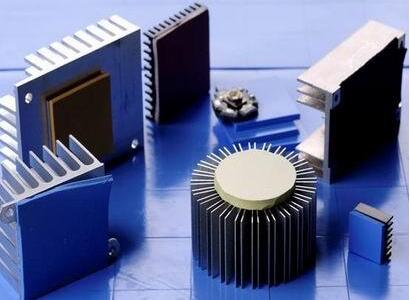"Heat-conducting silica gel sheet" is a kind of heat conductive medium material which is made of silica gel as base material, metal oxides and other auxiliary materials, and is synthesized through a special process. In the industry, it is also called thermal conductive silicone mat, thermal conductive silicon film, softness. Thermal pad, thermal silica pad and so on are specially designed to use the gap to transfer heat. It can fill the gap, complete the heat transfer between the heating part and the heat dissipation part, and also play the role of insulation, shock absorption, sealing, etc. The design requirements that can meet the requirements of miniaturization and ultra-thinning of the equipment are extremely process-friendly and usable, and have a wide range of thicknesses and an excellent thermal conductive filler material.

advantage
1, the material is soft, compression performance, thermal insulation properties, thickness adjustable range is relatively large, suitable for filling the cavity, both sides have a natural viscosity, operability and maintainability;
2. The main purpose of choosing the thermal silica film is to reduce the thermal contact resistance between the surface of the heat source and the surface of the heat sink. The thermal silica film can fill the gap of the contact surface.
3, because the air is a bad conductor of heat, it will seriously hinder the transfer of heat between the contact surfaces, and the thermal conductive silica film can be installed between the heat source and the radiator to push the air out of the contact surface.
4. With the supplement of thermal silica film, the contact surface between the heat source and the heat sink can be better fully contacted, and the face-to-face contact can be achieved. The temperature response can reach the smallest possible temperature difference;
5, the thermal conductivity of thermal silica film can be controlled, the thermal conductivity is also better;
7. The work process difference of the thermal silica film in the structure is bridged to reduce the process requirement of the radiator and the heat dissipation structure.
8, thermal silica film with insulation properties (this feature needs to be added in the production of suitable materials);
9, thermal silica film with shock absorption effect;
10, thermal silica film with the installation, testing, reusable convenience.
Shortcomings
Relative thermal grease, thermal silica has the following disadvantages:
1. Although the thermal conductivity is higher than that of the thermal grease, the thermal resistance is also higher than that of the thermal silica.
2. The thermal conductive silicone film with a thickness of 0.5 mm or less has a complicated process and a relatively high thermal resistance;
3, thermal grease temperature range is greater, they are thermal grease -60 °C ~ 300 °C, thermal silica film -50 °C ~ 220 °C;
4, price: thermal grease has been widely used, the price is low, thermal silica film used in notebook computers and other thin small precision electronic products, the price is slightly higher.

1, LED TV video equipment
2, network player household appliances
3, mobile power LED lighting
4, backlight module switching power supply
5, medical equipment communication equipment
6, PC server base station
Thermal silica film applications1, LED industry use
The thermal silica film is used between the aluminum substrate and the heat sink; the thermal silica film is used between the aluminum substrate and the shell.
2, household appliances industry
Microwave oven/air conditioner (fan motor power IC and housing)/induction cooker (between thermistor and heat sink).
3, PDP/LED TV application
Thermal conduction between the power IC, the image decoder IC, and the heat sink (housing).
4, automotive electronics industry applications
Such as xenon lamp ballast, audio, car series products, can be used to thermal silica film
5, communications industry
Set-top box DC-DC heat dissipation between the IC and the shell.

1. Keep the surface of the heat-conducting silica gel clean and avoid the contamination of the thermal silica film. The self-adhesiveness and the sealing thermal conductivity of the dirty thermal silica film will be poor.
2. When taking the thermal silica film, the large area of ​​thermal silica film should be grabbed from the center, and the smaller area of ​​the sheet is not required to be grabbed because the uneven thermal conductivity of the large thermal silica film will lead to deformation. Subsequent operations may even damage the silicone sheet.
3, the left hand holding the sheet, the right hand torn off one side of the protective film. The two sides of the protective film can not be torn off at the same time to reduce the number and area of ​​direct contact thermal silica film, to maintain the self-adhesion and thermal conductivity of the thermal silica film is not damaged.
4. Remove one side of the protective film and face the radiator. First align the thermal silica film with the heat sink. Slowly lower the thermal silica film. Be careful to avoid bubbles.
5. If bubbles are generated during operation, you can pull up the end of the silicon film and repeat the above steps, or gently wipe the bubbles with the help of a tool. The strength is not too great, so as to avoid damage to the thermal silica film.
6, tear off the other side of the protective film, into the heat sink, torn off a small protective film strength, to avoid pulling or pulling up thermal silica film.
7. After fastening or using strong adhesive thermal silica film, apply a certain pressure to the radiator and store it for a period of time to ensure that the thermal silica film is fixed.
Guangzhou Yunge Tianhong Electronic Technology Co., Ltd , https://www.e-cigarettesfactory.com
